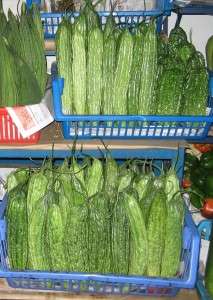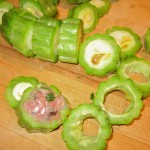 In the summer, my father used to grow one of his favorite vegetables, bitter melon (foo gwa). You might see it in farmers’ markets now. Their appearance prompts curious questions. They don’t look much like melons, their shape is more like a slender gourd or a plump cucumber. Their green skin is furrowed with deep wrinkles and their interior is filled with a white pithy mesh of seeds.
In the summer, my father used to grow one of his favorite vegetables, bitter melon (foo gwa). You might see it in farmers’ markets now. Their appearance prompts curious questions. They don’t look much like melons, their shape is more like a slender gourd or a plump cucumber. Their green skin is furrowed with deep wrinkles and their interior is filled with a white pithy mesh of seeds.
Like their name implies, they are bitter. Although Hakka and many Asians love their strong numbing bite, it may be an acquired taste for the uninitiated. I confess, even though I love bitter in many forms, I find this vegetable stronger than I like. Some cooks claim certain techniques mellow the bitterness. Some simmer the melon uncovered in broth, so the bitterness can dissipate. Marie Chang from Toronto adds tomato to the braising sauce to add some sweetness to balance the bitterness of the vegetable in her recipe (page 163).
Those who love this vegetable celebrate and savor its bitterness. Also many eat it for its health benefits. With all its claims, you might call it a super food. It is often referred to as a plant insulin and can help lower blood sugar. Perhaps that’s why my father ate so much bitter melon, he had diabetes. It is also high in iron, potassium, calcium. It claims to combat cancer, viruses, colds, psoriasis, and high cholesterol.
My father, like many Hakka, liked to stuff the melon. He cut the melon crosswise in rings, removed the seeds, and filled the cavity with a pork filling. He poached it in broth to make soup. See my father’s recipe in the cookbook on page 24. In Hong Kong, I ate a new version stuffed with glutinous rice, Chinese sausage or bacon, and Tianjin vegetables (page 74).
The stuffed rings are most commonly poached in broth, pan browned and braised, or steamed. You can also slice the melon and stir-fry it. Or imbed thin slices in a frittata-like omelet (page 80).
The next time you see this funny looking vegetable, be adventurous and give it a try. You might like it.

